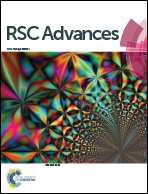A novel apatite-based warm white emitting phosphor Ba3GdK(PO4)3F:Tb3+, Eu3+ with efficient energy transfer for w-LEDs
Abstract
A Ba3GdK(PO4)3F:Tb3+, Eu3+ phosphor with fluoro-apatite-structure has been fabricated by a conventional high-temperature solid-state reaction. The crystal structure, component element and microstructure of the phosphor have been systematically investigated by X-ray diffraction refinement, X-ray photoelectron spectroscopy (XPS), scanning electron microscopy (SEM), transmission electron microscopy (TEM) and high-resolution TEM (HRTEM), respectively. The Ba3GdK(PO4)3F:Tb3+ phosphor shows a blue-greenish emission peak at 547 nm under excitation of 276 nm, while Ba3GdK(PO4)3F:Eu3+ displays a red emission peak near 620 nm with excitation at 396 nm. Efficient energy transfer from Tb3+ to Eu3+ ions takes place in the Ba3GdK(PO4)3F host, and the energy transfer critical distance between Tb3+ and Eu3+ ions along with the resonant energy-transfer mechanism are determined. By tuning the Tb3+/Eu3+ ratio, the emission hue can be modulated from blue-green (0.238, 0.311) to white (0.341, 0.318) and eventually to orange (0.521, 0.335). Moreover, the thermal quenching property of the as-prepared samples was studied in detail, which discloses the high thermal stability.


 Please wait while we load your content...
Please wait while we load your content...